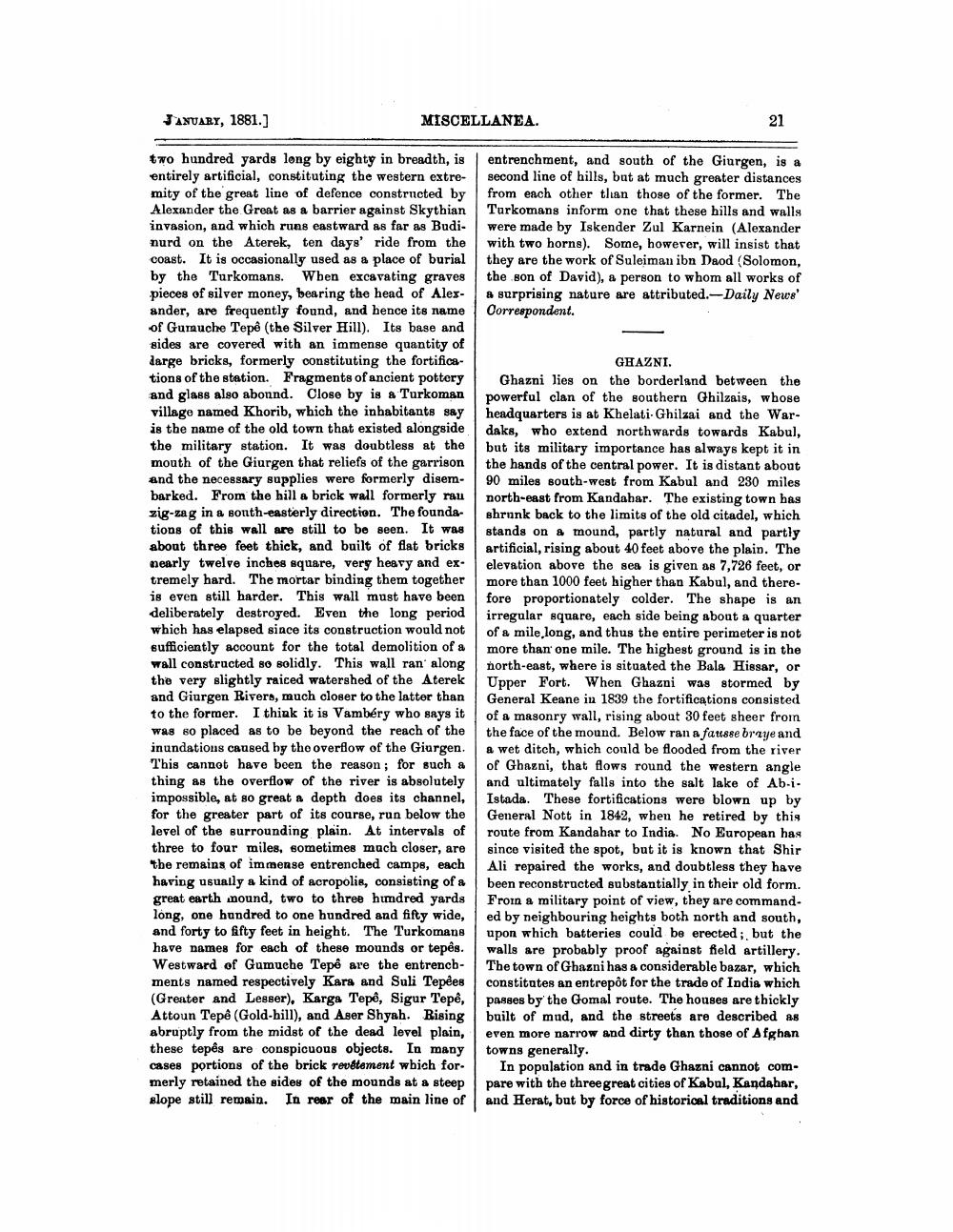________________
JANUARY, 1881.]
MISCELLANEA.
entrenchment, and south of the Giurgen, is a second line of hills, but at much greater distances from each other than those of the former. The Turkomans inform one that these hills and walls were made by Iskender Zul Karnein (Alexander with two horns). Some, however, will insist that they are the work of Suleiman ibn Daod (Solomon, the son of David), a person to whom all works of & surprising nature are attributed.-Daily News' Oorrespondent.
two hundred yards long by eighty in breadth, is entirely artificial, constituting the western extre- mity of the great line of defence constructed by Alexander the Great as a barrier against Skythian invasion, and which runs eastward as far as Budinurd on the Aterek, ten days' ride from the coast. It is occasionally used as a place of burial by the Turkomans. When excavating graves pieces of silver money, bearing the head of Ales. ander, are frequently found, and hence its name of Guruche Tepe (the Silver Hill). Its base and sides are covered with an immense quantity of darge bricks, formerly constituting the fortifications of the station. Fragments of ancient pottery and glass also abonnd. Close by is a Turkoman village named Khorib, which the inhabitants say is the name of the old town that existed alongside the military station. It was doubtless at the mouth of the Giurgen that reliefs of the garrison and the necessary supplies were formerly disem. barked. From the hill a brick wall formerly rau zig-zag in a sonth-easterly direction. The foundations of this wall are still to be seen. It was about three feet thick, and built of flat bricks nearly twelve inches equare, very heavy and extremely hard. The mortar binding them together is even still harder. This wall must have been deliberately destroyed. Even the long period which has elapsed since its construction would not sufficiently account for the total demolition of a wall constructed so solidly. This wall ran' along the very slightly raiced watershed of the Aterek and Giurgen Rivers, much closer to the latter than to the former. I think it is Vambéry who says it was so placed as to be beyond the reach of the inundations caused by the overflow of the Giurgen. This cannot have been the reason; for such a thing as the overflow of the river is absolutely impossible, at so great a depth does its channel, for the greater part of its course, run below the level of the surrounding plain. At intervals of three to four miles, sometimes much closer, are the remains of immense entrenched camps, each having usually a kind of acropolis, consisting of a great earth wound, two to three himdred yards long, one hundred to one hundred and fifty wide, and forty to fifty feet in height. The Turkomans have names for each of these mounds or tepês. Westward of Gumuche Tepê are the entrenchments named respectively Kara and Suli Tepees (Greater and Lesser), Karga Tepê, Sigur Tepe, Attoun Tepê (Gold-hill), and Aser Shyah. Rising abruptly from the midst of the dead level plain, these tepês are conspicuous objects. In many cases portions of the brick roustement which for. merly retained the sides of the mounds at a steep slope still remain. In rear of the main line of
GHAZNI. Ghazni lies on the borderland between the powerful clan of the southern Ghizais, whose headquarters is at Khelati Ghilzai and the Wardaks, who extend northwards towards Kabul, but its military importance has always kept it in the hands of the central power. It is distant about 90 miles south-west from Kabul and 230 miles north-east from Kandahar. The existing town has shrunk back to the limits of the old citadel, which stands on a mound, partly natural and partly artificial, rising about 40 feet above the plain. The elevation above the sea is given as 7,726 feet, or more than 1000 feet higher than Kabul, and there. fore proportionately colder. The shape is an irregular square, each side being about a quarter of a mile long, and thus the entire perimeter is not more than one mile. The highest ground is in the north-east, where is situated the Bala Hissar, or Upper Fort. When Ghazni was stormed by General Keane in 1839 the fortifications consisted of a masonry wall, rising about 30 feet sheer from the face of the mound. Below ran a fausse braye and a wet ditch, which could be flooded from the river of Ghazni, that flows round the western angle and ultimately falls into the salt lake of Ab-i. Istada. These fortifications were blown up by General Nott in 1842, when he retired by this route from Kandahar to India. No European has since visited the spot, but it is known that Shir Ali repaired the works, and doubtless they have been reconstructed substantially in their old form. Froin a military point of view, they are commanded by neighbouring heights both north and south, upon which batteries could be erected; but the walls are probably proof against field artillery. The town of Ghazni has a considerable bazar, which constitutes an entrepôt for the trade of India which passes by the Gomal route. The houses are thickly built of mud, and the streets are described as even more narrow and dirty than those of Afghan towns generally.
In population and in trade Ghazni cannot compare with the three great cities of Kabul, Kandahar, and Herat, but by force of historical traditions and




